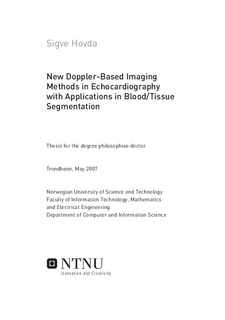| dc.contributor.advisor | Olstad, Bjørn | nb_NO |
| dc.contributor.advisor | Rue, Håvard | nb_NO |
| dc.contributor.author | Hovda, Sigve | nb_NO |
| dc.date.accessioned | 2014-12-19T13:29:25Z | |
| dc.date.available | 2014-12-19T13:29:25Z | |
| dc.date.created | 2007-05-02 | nb_NO |
| dc.date.issued | 2007 | nb_NO |
| dc.identifier | 122325 | nb_NO |
| dc.identifier.isbn | 978-82-471-2050-7 | nb_NO |
| dc.identifier.uri | http://hdl.handle.net/11250/249705 | |
| dc.description.abstract | Part 1: The bandwidth of the ultrasound Doppler signal is proposed as a classification function of blood and tissue signal in transthoracial echocardiography of the left ventricle. The new echocardiographic mode, Bandwidth Imaging, utilizes the difference in motion between tissue and blood. Specifically, Bandwidth Imaging is the absolute value of the normalized autocorrelation function with lag one. Bandwidth Imaging is therefore linearly dependent on the the square of the bandwidth estimated from the Doppler spectrum. A 2-tap Finite Impulse Response high-pass filter is used prior to autocorrelation calculation to account for the high level of DC clutter noise in the apical regions. Reasonable pulse strategies are discussed and several images of Bandwidth Imaging are included. An in vivo experiment is presented, where the apparent error rate of Bandwidth Imaging is compared with apparent error rate of Second-Harmonic Imaging on 15 healthy men. The apparent error rate is calculated from signal from all myocardial wall segments defined in \cite{Cer02}. The ground truth of the position of the myocardial wall segments is determined by manual tracing of endocardium in Second-Harmonic Imaging. A hypotheses test of Bandwidth Imaging having lower apparent error rate than
Second-Harmonic Imaging is proved for a p-value of 0.94 in 3 segments of end diastole and 1 segment in end systole on non averaged data. When data is averaged by a structural element of 5 radial, 3 lateral and 4 temporal samples, the numbers of segments are increased to 9 in end diastole and to 6 in end systole. These segments are mostly located in apical and anterior wall regions. Further, a global measure GM is defined as the proportion of misclassified area in the regions close to endocardium in an image. The hypothesis test of Second-Harmonic Imaging having lower GM than Bandwidth Imaging is proved for a p-value of 0.94 in the four-chamber view in end systole in any type of averaging. On the other side, the hypothesis test of Bandwidth Imaging having lower GM than Second-Harmonic Imaging is proved for a p-value of 0.94 in long-axis view in end diastole in any type of averaging. Moreover, if images are averaged by the above structural element the test indicates that Bandwidth Imaging has a lower apparent error rate than Second-Harmonic Imaging in all views and times (end diastole or end systole), except in four-chamber view in end systole. This experiment indicates that Bandwidth Imaging can supply additional information for automatic border detection routines on endocardium.
Part 2: Knowledge Based Imaging is suggested as a method to distinguish blood from tissue signal in transthoracial echocardiography. This method utilizes the maximum likelihood function to classify blood and tissue signal. Knowledge Based Imaging uses the same pulse strategy as Bandwidth Imaging, but is significantly more difficult to implement. Therefore, Knowledge Based Imaging and Bandwidth Imaging are compared with Fundamental Imaging by a computer simulation based on a parametric model of the signal. The rate apparent error rate is calculated in any reasonable tissue to blood signal ratio, tissue to white noise ratio and clutter to white noise ratio. Fundamental Imaging classifies well when tissue to blood signal ratio is high and tissue to white noise ratio is higher than clutter to white noise ratio. Knowledge Based Imaging classifies also well in this environment. In addition, Knowledge Based Imaging classifies well whenever blood to white noise ratio is above 30 dB. This is the case, even when clutter to white noise ratio is higher than tissue to white noise ratio and tissue to blood signal ratio is zero. Bandwidth Imaging performs similar to Knowledge Based Imaging, but blood to white noise ratio has to be 20 dB higher for a reasonable classification. Also the highpass filter coefficient prior to Bandwidth Imaging calculation is discussed by the simulations. Some images of different parameter settings of Knowledge Based Imaging are visually compared with Second-Harmonic Imaging, Fundamental Imaging and Bandwidth Imaging. Changing parameters of Knowledge Based Imaging can make the image look similar to both Bandwidth Imaging and Fundamental Imaging. | nb_NO |
| dc.language | eng | nb_NO |
| dc.publisher | Fakultet for informasjonsteknologi, matematikk og elektroteknikk | nb_NO |
| dc.relation.ispartofseries | Doktoravhandlinger ved NTNU, 1503-8181; 2007:93 | nb_NO |
| dc.subject | Ultrasound | en_GB |
| dc.subject | Border Detection | en_GB |
| dc.subject | Imaging | en_GB |
| dc.subject | Doppler Signal | en_GB |
| dc.subject | Segmentation | en_GB |
| dc.subject | Heart | en_GB |
| dc.subject | MEDICINE: Physiology and pharmacology: Physiology: Medical technology | en_GB |
| dc.title | New Doppler-Based Imaging Methods in Echocardiography with Applications in Blood/Tissue Segmentation | nb_NO |
| dc.type | Doctoral thesis | nb_NO |
| dc.source.pagenumber | 158 | nb_NO |
| dc.contributor.department | Norges teknisk-naturvitenskapelige universitet, Fakultet for informasjonsteknologi, matematikk og elektroteknikk | nb_NO |
| dc.description.degree | PhD i medisinsk teknologi | nb_NO |
| dc.description.degree | PhD in Medical Technology | en_GB |
